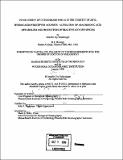Involvement of cytochrome P450 1A in the toxicity of aryl hydrocarbon receptor agonists : alteration of arachidonic and acid metabolism and production of reactive oxygen species
Author(s)
Schlezinger, Jennifer Joy
DownloadFull printable version (39.81Mb)
Other Contributors
Woods Hole Oceanographic Institution.
Advisor
John J. Stegeman.
Terms of use
Metadata
Show full item recordAbstract
Two cytochrome P4501A-dependent mechanisms of aryl hydrocarbon receptor (AhR) agonist toxicity were examined in the marine teleost scup (Stenotomus chrysops), alteration of arachidonic acid (AA) metabolism and production of reactive oxygen species (ROS). In scup hepatic microsomes, cytochrome P450s including CYP1A and CYP2B-like proteins catalyzed regioselective metabolism of AA to eicosatrienoic and hydroxyeicosatetraenoic acids. Benzo[a]pyrene (BP) treatment induced liver microsomal AA metabolism, but that effect varied with season. Endogenous AA epoxides were recovered from scup liver, heart, and kidney, and their composition in the liver was altered by treatment with BP or 2,3,7,8-tetrachlorodibenzo-p-dioxin. In scup and mammals, the formation of ROS was stimulated by binding of 3,3',4,4-tetrachlorobiphenyl (TCB) to CYP1A, apparently CYP1A1. Attack of that ROS inactivated scup CYP1A. ROS release and inactivation of CYPlA were stimulated only by substrates of CYP1A that are slowly metabolized. In vivo, 3,3',4,4',5- pentachlorobiphenyl (PeCB) potently induced CYPlA mRNA, protein and catalytic activity at low doses (0.01-0.1 mg/kg), suppressed induction of CYPlA protein and catalytic activity at a high dose (1 mg/kg) and transiently induced oxidative stress in scup liver. The suppression of CYP1A induction was organ-dependent, with hepatic CYP1A being most susceptible to inactivation. The results suggest that ROS could be involved in the in vivo suppression of scup liver CYP1A by planar halogenated aromatic hydrocarbons. The reactive oxygen sensitive transcription factor, nuclear factor-KB (NF-KB), was characterized in scup. An NF-KB consensus binding sequence bound specifically to 3 proteins in scup liver, heart and kidney. One protein was recognized by an antibody to mammalian p50. Injection alone appeared to activate NF-KB. BP did not increase the activation of NF-KB, and PeCB activated NF-KB in only 1 of 2 experiments. Last, CYP1A induction in endothelial cells of the American eel (Anguilla rostrata), a site which may be particularly susceptible to alterations in AA metabolism and ROS production, was described. Eel liver CYPlA responded to BP, 13-naphthoflavone and TCB in a dose-dependent fashion, and induction was correlated with hepatic inducer concentration. Endothelial CYP1A was inducible in a number of organs and was metabolically active. In the rete mirabile, penetration of endothelial CYP1A induction increased with increasing dose of AhR agonists, corresponding with an increase in inducer concentration. A transition from endothelial to epithelial staining occurred in the gill, heart and kidney at high inducer doses.
Description
Thesis (Ph. D.)--Joint Program in Biological Oceanography (Massachusetts Institute of Technology, Dept. of Biology; and the Woods Hole Oceanographic Institution), 1998. "August, 1998." Includes bibliographical references (p. 219-254).
Date issued
1998Department
Joint Program in Biological Oceanography.; Woods Hole Oceanographic Institution; Massachusetts Institute of Technology. Department of BiologyPublisher
Massachusetts Institute of Technology
Keywords
Joint Program in Biological Oceanography., Biology., Woods Hole Oceanographic Institution.